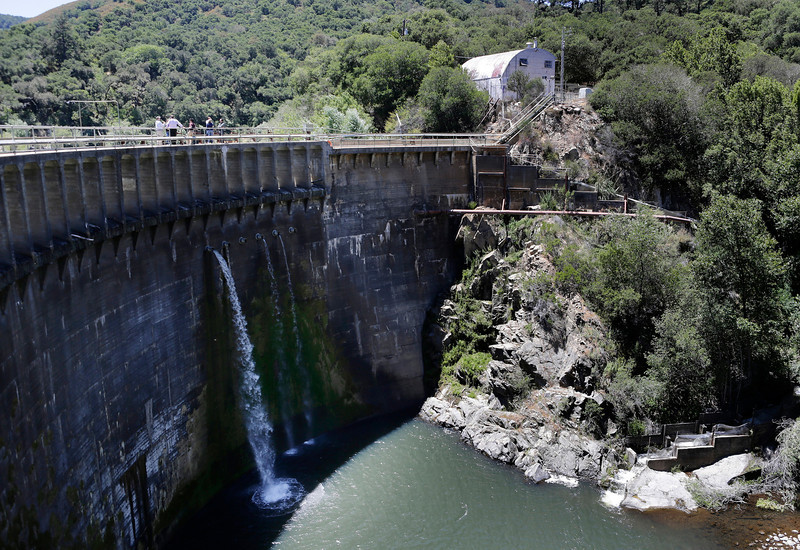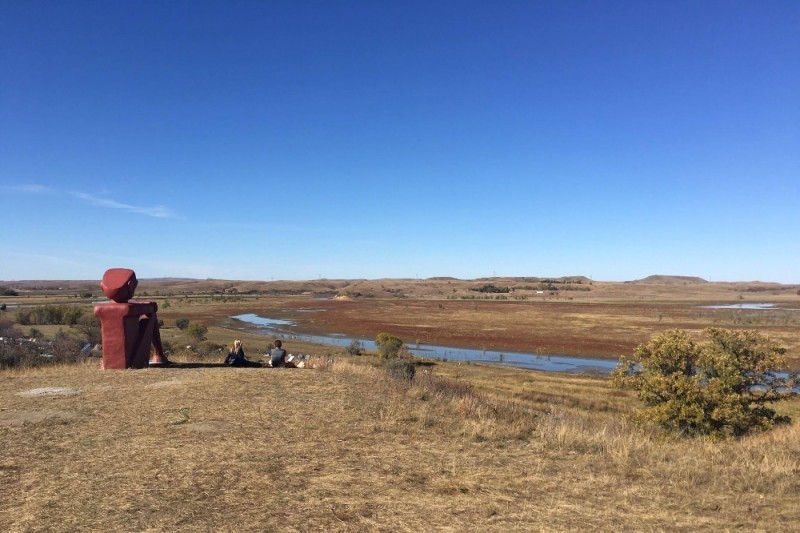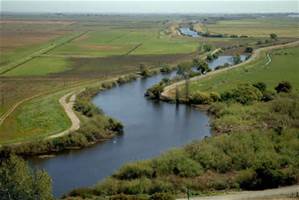Wild Ride Awaits for Water Issues Under Trump
by Matt Weisser
Like his vow to build a border wall, Trump’s promises around water issues will be difficult to fulfill. And the path to get there could be disruptive for water agencies and the environment.
Donald Trump made some big campaign promises about water during his election campaign. Now that he has been elected president, those promises could dramatically shake up how water is managed in the arid West.
In one of his few direct statements about water, Trump has said he wants to invest in treatment systems to prevent problems caused by aging distribution lines, citing as an example the drinking-water contamination in the Michigan city of Flint. To do this, he proposes to triple funding for a federal loan program, called the state revolving fund, from the current $2 billion to $6 billion.
This could be a boon to local water and wastewater utilities struggling to pay for decaying infrastructure.
Paradoxically, Trump has also vowed to slash Clean Water Act regulations. In particular, he is targeting rules adopted by the Obama administration to protect wetlands and marshes, the nation’s natural water filters.
Like Trump’s vow to build a wall on the Mexican border, these proposed changes would encounter a host of inconvenient realities associated with government. Working that out is certain to be disruptive, whatever the outcome.
“Certainly what we’re hearing out of the Trump administration is encouraging to the water utility sector,” said G. Tracy Mehan, executive director of government affairs at the American Water Works Association. “But I don’t know how you triple the state revolving fund. There’s just a lot of unknowns.”
The AWWA, based in Denver, CO, has identified a need to spend $1 trillion rebuilding the nation’s drinking water systems over the next 25 years – just to maintain existing levels of service. The state revolving fund, a federal low-interest loan program overseen by the Environmental Protection Agency, is the backbone of infrastructure funding for water utilities.
But Mehan – who was an assistant administrator for water programs at the EPA during the George W. Bush administration – said adding $4 billion to the loan program would be a tall order; it would require cutting a similar amount from other government programs. Mehan said it’s “really unclear” how that will happen in a Congress that fights to protect every dollar spent on existing programs.
Trump also plans to convince private investors to spend $1 trillion on public infrastructure projects. He claims he can entice them to do this by giving them generous tax credits.
But Mark Lubell, director of the Center for Environmental Policy and Behavior at the University of California, Davis, said tax breaks are not enough to drive that kind of investment because there is no profit being offered.
“They’re not going to invest in a flood management system, for example, where they get no revenue from somebody – even with the tax breaks,” Lubell said. “That’s where we need to convince the Trump officials that a more traditional infrastructure plan is consistent with their strategy.”
The way to do that, he said, is to highlight the economic benefits that come with building environmental infrastructure. Projects like levee construction, floodplain restoration, modern water lines and sewage treatment facilities all support thousands of jobs; they foster domestic manufacturing and protect the nation from disasters and health crises that harm economic productivity.
“If you connect those issues to climate change or endangered species, I don’t think that’s going to fly in a new Trump administration,” Lubell said. “But what would fly is an economic argument.”
Trump, the first property developer to be elected president, has vowed to eliminate the so-called Clean Water Rule (also known as the “waters of the U.S. rule”) adopted by the outgoing Obama administration. This regulation was crafted to clarify decades of uncertainty about which water bodies are subject to development restrictions under the Clean Water Act.
The rule resulted from a lengthy regulatory process triggered by court rulings. Its goal is to protect surface water expanses – marshes, wetlands, floodplains and small streams – that act as natural filters and conduits for drinking-water sources.
Lubell said eliminating the rule would not be simple; it would require a new rulemaking process that would likely take years. Simply suspending it would mean the regulations reverted to their prior state, which were a source of frustration because they were vague.
“He doesn’t realize what it takes to change a regulation or rule,” Lubell said. “You can’t just go and magic-wand everything, which he apparently thinks is possible.”
One water arena where Trump’s team may have a lot of influence is dams. The new water infrastructure bill approved by Congress in December gives certain cabinet secretaries unprecedented powers to enlarge existing dams and build new ones.
The normal path to federal dam building involves a thorough environmental review by a federal agency such as the Bureau of Reclamation. Then the project is vetted by a congressional authorizing committee, such as the House Natural Resources Committee, which determines if the project is a wise investment of public dollars and a worthy environmental risk.
These practices were pushed through a generation ago by then-president Ronald Reagan to rein in pork-barrel spending.
The new legislation, however, allows the interior secretary single-handedly to approve new dams without congressional authorization. The secretary can also rely on environmental reviews done by a third party.
It also grants the army secretary powers to enlarge Army Corps of Engineers dams for water storage in cases where they now mainly provide flood control.
The bill allocates $335 million for new reclamation dam projects. That is not enough to fund even one new dam, but it could jump-start a number of projects with the assumption that more federal money will be allocated later.
Therein lies the problem, says Ronald Stork, a senior policy adviser at Friends of the River. The existing approval process was created to ensure a reservoir proposal is based on reliable cost estimates and avoids unforeseen obstacles that could halt construction – such as insufficient water to fill it.
That is a concern with projects like the proposed Temperance Flat dam on California’s San Joaquin River. The California Water Resources Control Board, which allocates water rights, has already determined the river is “fully appropriated” – meaning it has no water left for new storage projects.
“The rules have been set up to make sure we don’t have circumstances where these half-baked projects get authorization,” said Stork, who has monitored federal water projects for decades. As a result, he said, “the administration is likely to not be a gatekeeper any more.”
Republican congressman Ryan Zinke is Donald Trump’s choice to lead the Interior Department, an agency with broad responsibility over water issues, endangered species and public lands. Zinke has acted as a congressman to shortcut environmental regulations.
Zinke supported a controversial bill by Rep. David Valadao (R-Hanford) that would have amended the Endangered Species Act to free up water supplies in California. It would also have erased a Bureau of Land Management (BLM) finding that the San Joaquin River canyon to be dammed by Temperance Flat is eligible for federal Wild and Scenic River status.
Valadao recently introduced a new version of the bill, no doubt hoping it will face better odds in the new Republican-controlled Congress.
Zinke also sponsored bills in 2015 requiring the Federal Energy Regulatory Commission to extend licenses for hydro-power development at two existing Montana dams. The licenses expired because the projects either had insufficient funding or no power lines existed to serve them. The bills became law when they were tacked on to the Energy Policy Modernization Act, approved by Congress in April.
As interior secretary, Zinke will be in charge of both the Bureau of Reclamation and the BLM, as well as the U.S. Fish and Wildlife Service, the federal agency that protects freshwater and terrestrial endangered species.
In 2015, Zinke received a 3 percent rating from the League of Conservation Voters for his actions on environment-related legislation in the House. He supported bills to weaken the Clean Water Act, eliminate stream buffers at surface mining projects and allow large logging projects on federal land to skip environmental reviews.
Trump’s appointments to a slightly more obscure agency, the Federal Energy Regulatory Commission (FERC), have received little attention but could have lasting impacts. Within months of inauguration, Trump will be able to seat a new majority on the commission, as well as a new chairman.
The FERC issues federal licenses for hydro-power dams, typically with 50-year terms. Many of the licenses for large dams in the West are now coming due for renewal. In California, for instance, there are 22 hydro-power relicensings pending and another 18 expected to come forward in the next four years.
A 1986 law required the FERC to give equal consideration to energy and environmental issues. It also required it to seek recommendations from federal natural resources agencies during dam relicensing.
As a result, in many recent proceedings it compelled dam owners to install fish ladders for the first time and increase water releases for aquatic habitat and recreation.
But Stork said the federal agencies under Trump could stop making those recommendations, and the new FERC commissioners could place less value on them.
“There is a probability that the resources agencies … are going to be essentially asked to stand down on their environmental mission for the duration of this administration,” said Stork. “They don’t have to change the law to do that. They just have to stop enforcing the law or, basically, reinterpret their mission.”
That would be a big setback for river environments affected by dams. But it would save dam owners billions of dollars and lots of red tape.
Some states have their own rigorous environmental laws that may help take the sting out of any changes in federal policy. California, for instance, has its own clean water law, known as the Porter-Cologne Act, and its own Endangered Species Act, both of which are more rigorous than federal law. So it might be able to avoid backsliding on some environmental reforms.
“I don’t think they can drive it in that direction in California, because we’re a blue state with a healthy Democrat-controlled legislature and a governor that holds environmental values pretty strongly,” said Tim Quinn, executive director of the Association of California Water Agencies. “We don’t want to see those regulations go away at all.”
The ACWA represents 430 public agencies – urban and rural – responsible for 90 percent of the water supplied to California’s farms and cities.
Quinn notes that Trump was elected, in part, by exploiting the issues that divide rural and urban voters. One of those, he said, is water, which makes it an issue that California and other Western states can use to connect with the Trump administration.
“In California, the rural-urban split is not entirely about water, but water is a huge factor in that,” said Quinn. “If we offer up ways to heal those wounds around one of the issues that divides us, I choose to believe we can get them interested.”
Adapted from News Deeply.
Pure Water Gazette Fair Use Statement
















